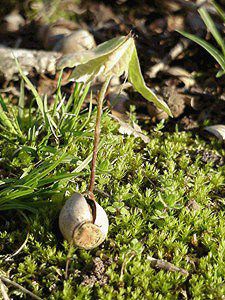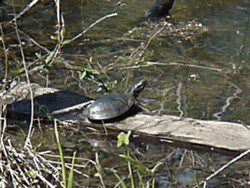 After last week's inch-and-a-half of rain, acorns beneath the giant White Oak (Quercus alba) at Hilton Pond Center have begun to show new life. Typically, acorns from the white oak group germinate in late fall when the radicle ("first root") develops within the shell and bursts through, extending downward into the soil and sometimes elevating the acorn above the substrate. Come spring--perhaps due to a combination of available moisture, lengthening photoperiod, and increasing temperatures--the acorn halves produce a stem that, in turn, gives rise to two tiny cotyledon leaves that are still unmistakably from a White Oak. (Photo © Hilton Pond Center) After last week's inch-and-a-half of rain, acorns beneath the giant White Oak (Quercus alba) at Hilton Pond Center have begun to show new life. Typically, acorns from the white oak group germinate in late fall when the radicle ("first root") develops within the shell and bursts through, extending downward into the soil and sometimes elevating the acorn above the substrate. Come spring--perhaps due to a combination of available moisture, lengthening photoperiod, and increasing temperatures--the acorn halves produce a stem that, in turn, gives rise to two tiny cotyledon leaves that are still unmistakably from a White Oak. (Photo © Hilton Pond Center)
 With afternoon temperatures in the high 60s and low 70s this week and last, ever-larger numbers of ever-larger turtles have been sunning themselves on the banks of Hilton Pond. Some have even become partially arboreal, climbing out of the water onto tree branches that fell halfway into the water during the January 2000 ice storm. The turtles are easily seen because the sun literally glistens off their smooth, greenish-black shells. Some appear to be River Cooters (Chrysemys concinna), but because they are extremely wary and slide into the pond at the slightest sign of danger, it's difficult to photograph or positively identify them; it doesn't help that River Cooters and Florida Cooters (C. floridana) have overlapping ranges in the Carolina Piedmont and frequently hybridize. There may also be Yellowbelly Sliders (C. scripta) and Painted Turtles (C. picta) in the herd. (That's a Painted Turtle in the photo above.) Most of the local turtles have carapaces (top shells) that look to be 5"-7" long, but the biggest are 10"-12". Obviously we need to do more work on the turtle inventory at Hilton Pond Center! (Photo © Hilton Pond Center) With afternoon temperatures in the high 60s and low 70s this week and last, ever-larger numbers of ever-larger turtles have been sunning themselves on the banks of Hilton Pond. Some have even become partially arboreal, climbing out of the water onto tree branches that fell halfway into the water during the January 2000 ice storm. The turtles are easily seen because the sun literally glistens off their smooth, greenish-black shells. Some appear to be River Cooters (Chrysemys concinna), but because they are extremely wary and slide into the pond at the slightest sign of danger, it's difficult to photograph or positively identify them; it doesn't help that River Cooters and Florida Cooters (C. floridana) have overlapping ranges in the Carolina Piedmont and frequently hybridize. There may also be Yellowbelly Sliders (C. scripta) and Painted Turtles (C. picta) in the herd. (That's a Painted Turtle in the photo above.) Most of the local turtles have carapaces (top shells) that look to be 5"-7" long, but the biggest are 10"-12". Obviously we need to do more work on the turtle inventory at Hilton Pond Center! (Photo © Hilton Pond Center)
|
